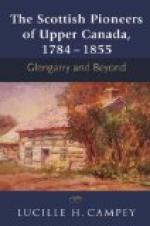Though extremely fond of singing—they sang when they were merry; when they thought they were going to die; when they were victorious in hunting, love, or war; when they were defeated; when they were paddling a canoe or sewing a moccasin—they had but a poor range of musical instruments. Most of the tribes used flutes made out of the wing bones of cranes or out of reeds, and some had small trumpets of wood, bark, or buffalo horn. The Pacific coast Indians made gongs or “xylophones” out of blocks or slabs of resonant wood.
Here is a specimen of Amerindian singing. It is the song which accompanied the famous Calumet dance in celebration of the peacemaking qualities of tobacco-smoking. It was taken down by the Jesuit missionaries in the seventeenth century from the Ilinwa (Illinois) Algonkin Indians of the middle west, and its notation reminds one of Japanese music.
[Musical notation and words:
THE CALUMET OR TOBACCO-PIPE DANCE
Ni-na-ha-ni, ni-na-ha-ni, ni-na-ha-ni na-ni on-go; Ni-na-ha-ni, ni-na-ha-ni, ni-na-ha-ni ho-ho; ni-na-ha-ni, ni-na-ha-ni, ni-na-ha-ni, Ka-wa ban-no-ge at-chi-cha Ko-ge a-ke a-w[-a]; Ba-no-ge a-chi-cha sha-go-be he, he, he! Min-tin-go mi-ta-de pi-ni, pi-ni he! A-chi-cha le ma-chi mi nam ba mik-tan-de, mik-tan-de pi-ni, pini he!]
Ninahani, &c, ongo;
ninahani, &c, hoho; ninahani, &c.
Kawa bannoge atchicha
Koge ake aw[-a];
Banoge atchicha shagobe
he he he! Mintingo mitade
Pini pini he! Atchicha
le machi mi nam ba miktande,
Miktande pini pini he!
Dancing was little else than posturing and jumping in masks—usually made to look like the head of a wild beast. But the men were usually very athletic. Wrestling competitions were almost universal, especially as a means of winning a wife. The conqueror in a wrestling match took the wife or wives of the defeated man. Their running powers for endurance and speed became justly celebrated.
“Their principal and most inveterate game is that of the hoop,” writes Alexander Henry, sen., “which proves as ruinous to them as the platter does to the Saulteurs (Ojibwe).” This game was played in the following manner. A hoop was made about two feet in diameter, nearly covered with dressed leather, and trimmed with quillwork, feathers, bits of metal, and other trinkets, on which were certain particular marks. Two persons played at the same time, by rolling the hoop and accompanying it, one on each side; when it was about to fall, each gently threw one arrow in such a manner that the hoop might fall upon it, and according to that mark on the hoop which rested on the arrows they reckoned the game. They also played another game by holding some article in one hand, or putting it into one of two shoes, the other hand or shoe being empty. They had another game which required forty to fifty small sticks, as thick as a goose quill and about a foot long; these were all shuffled together and then divided into two bunches, and according to the even or odd numbers of sticks in the bunch chosen, the players lost or won.




